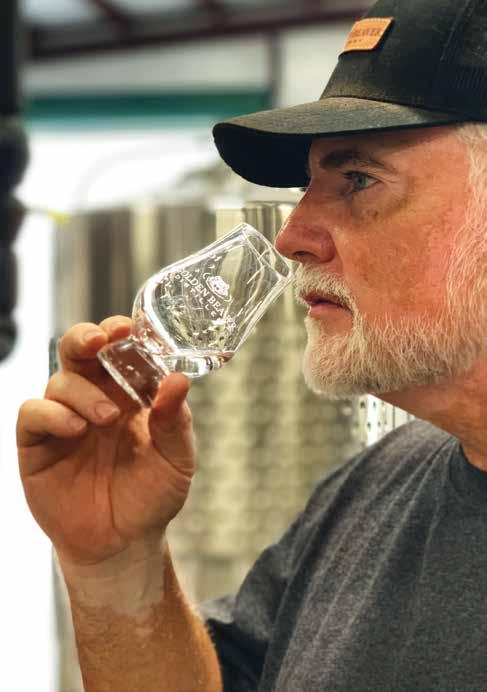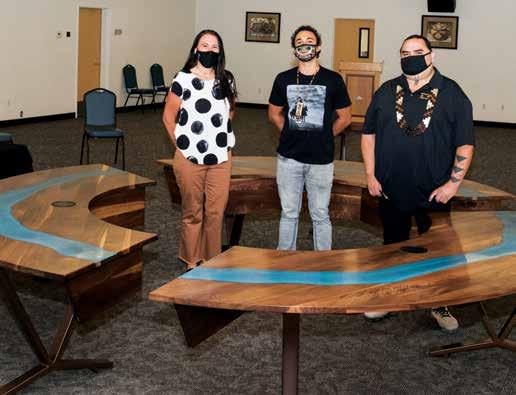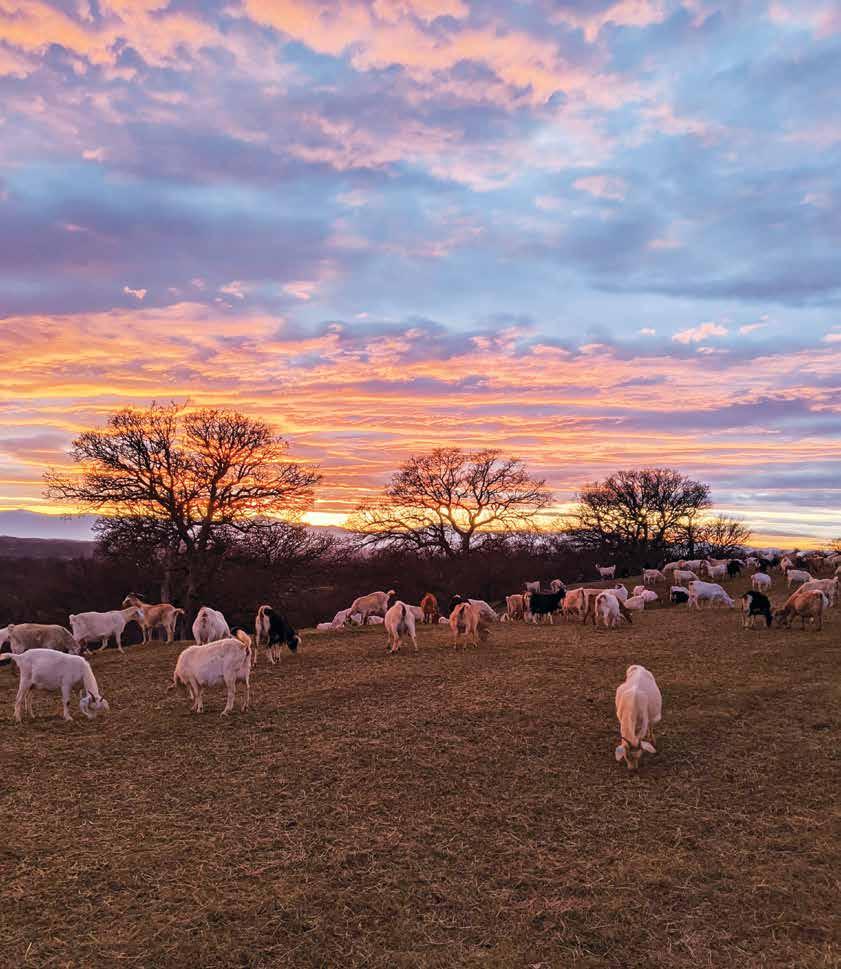
12 minute read
good finds
LEAVE IT TO BEAVER
GOLDEN BEAVER DISTILLERY IN CHICO
CHICO’S KRIS KOENIG was one of millions of people worldwide who had their air travel schedules abruptly altered in 2010 by the volcano eruptions in Iceland. His unexpected extra two nights in Edinburgh, Scotland, however, had an impact that would bring him to the 2020 launch of his new business, Golden Beaver Distillery.
In 2010, Koenig was a film director and producer and had flown to Edinburgh to screen his PBS documentary, “400 Years of the Telescope,” at the Edinburgh Science Festival. The festival was organized by the niece of famed whiskey expert Charlie MacLean, who was kind enough to make an introduction when Koenig’s flight home was delayed. MacLean and Koenig “sampled many, many distillates” over the two days and a new passion was ignited in the American. “It was just mind blowing,” says Koenig. “And very eye opening. You can create a product using the same basic ingredients and have such a wide variety of flavors. And I just got the bug.”
Koenig went on to direct and produce “Assaulted: Civil Rights Under Fire” (2013) and “Sight: The Story of Vision” (2016), all the while engaging his curiosity in distilled spirits. First he went on a Scotch binge, he says. Then he got into bourbons. He may have experimented with home distillation, but won’t confirm. He also enrolled in Moonshine University in Louisville, Ky., which has introduced him to many industry experts, including Dr. Pat Heist of Ferm Solutions and Wilderness Trail Distillery.4 continued on page 44


Finally, he was ready to make a career change. He quit filmmaking completely in 2019 and dove into distillation with passion and committed partners. “To open a distillery takes a lot of permitting, licensing and capital. It’s usually a three- to four-year process,” he says. Golden Beaver opened its tasting room doors in November 2020 with Keepers Shine Honey Spirit and Beaver Likker Moonshine. Keepers Shine was created with honey from Chico Honey Company/Olivarez Honey Bees, and Beaver Likker is a rice-based moonshine from local crops.
“Honey spirits are relatively new,” says Koenig, noting that they are different from mead. “We actually approach making the spirit more like you would making a whiskey.” The result, he says, is a “cross between gin and tequila with a clean mouthful.”
The company has been adding spirits ever since, including High Lakes Vodka, Pacific Flyway Whiskey, Chico Creek Rye, Butte Creek Bourbon and many others. “We want Golden Beaver to be a great entry to spirits,” says Koenig, looking forward to the lifting of COVID-19 restrictions so guests can sample and learn in his tasting room and use the event center on premises. Tours will be available when safe.
Distillation is currently done on two pot stills, nicknamed Harold and Maude. A Tennessee Thumper Still is being added to the family that will produce short-run specialty moonshines that are flavored with fruit and spices. “Every week we’ll have something unique for people to come up here and taste,” says Koenig. “And it will only be available in the tasting room.”
Like many good ideas, the name for the distillery was born on a road trip. Koenig and his wife Marianne were traveling back to Chico from their cabin in Colorado when they saw a sign for Beaver Liquors. It gave them a chuckle but spurred a conversation about local beaver populations that Marianne had learned about volunteering at a museum in Paradise. They decided to name the new business Golden Beaver and dedicate a portion of each sale to Occidental Arts and Ecology Center’s Water Institute and its Bring Back the Beaver Campaign. “Part of our mission would be to foster work with nonprofits working with beaver habitat and beaver education,” says Koenig.
The company has also supported rebuilding the Honey Run Bridge through special sales of Honey Run Honey Flavored Whiskey. A December release sold out in less than three hours and raised $15,600 for the efforts of Rebuild Honey Run Covered Bridge. A Valentine’s Day fundraiser is coming up for the same cause.
Distilling may be a difficult business to get into, and 2020 was certainly a challenging year to launch a new endeavor, but Koenig is enjoying it so far. “My background is very entrepreneurial,” he says. “I’m very comfortable in that environment.” Cheers to that. •
Golden Beaver Distillery www.goldenbeaverdistillery.com 13464 Browns Valley Drive, Chico
Melissa Mendonca is a graduate of San Francisco State and Tulane universities. She’s a lover of airports and road trips and believes in mentoring and service to create communities everyone can enjoy. Her favorite words are rebar, wanderlust and change.



Time To Plant
Bare Root Fruit Trees, Berries, Grapes & Perennial Veggies
VISIT OUR GIFT SHOP
Valentine's Day is Feb 14th! Gifts for your Loved Ones, Houseplants & More!
Your Partner for Successful Gardening Wyntour Gardens 530-365-2256
Open Monday thru Saturday 8am to 5pm & Sundays 10am to 4pm
8026 Airport Road (1 mi. S. of the Redding Airport, next to Kent’s Mkt) Check our website or FB for upcoming events wyntourgardens.com
BUILD CONFIDENCE HAVE FUN RIDE SAFELY


• Professional Racer & Instructor, Hawk Mazzotta • Certified USMCA Dirt Bike Coach • Kids camps • Women’s camps • Private lessons • Pro camps • Man camps • Mini bike races



SPONSORS… The Tweedy Family, Akana Veterinary
Services, Signsations, 2nd Amendment Ink, Platinum Auto Glass, Redding Yamaha Seadoo,
Enjoy Magazine and Enjoy the Store,
Half Moon Sanitation,
M Squared Ranch.
INSTRUCTIONAL MOTORCYCLE CAMP DESIGNED FOR ALL AGES, SKILL LEVELS AND VARIOUS DISCIPLINES OF RIDING AND RACING
530. 567. 4004
HAWKMAZZOTTA@GMAIL.COM HAWKMAZZOTTAMOTOCAMP.COM @HAWKMAZZOTTA_MOTOCAMP
crafted with purpose
CUSTOM WOODCRAFTER RECLAIMS NATIVE TRADITION

THE ARTIST DESIGNS a space where people feel connected and heard. Woodworker Stephan Cheney selects his material with purpose, engraves it with symbols representing all three tribes united as Redding Rancheria, and shapes it to reclaim the space of their ancestors, where forest covered the land unbroken and river nourished its people with a cycle eternal since the beginning of time.
The tribes order a special table for Redding Rancheria. They seek a design with purpose. Joined as one, people of the Wintu, the Yana and the Pit River work with Cheney, a Lakota man, to craft a kind of furniture that can change the way space in their courtroom is used. Jack Potter Jr., chairman of Redding Rancheria, sees the construct of the table as a tool of equalization; the three parties in a tribal court case will face each other equally spaced, on an equal level.
The judge approves the change. Tribal Judge Richard Blake envisions himself seated at a curved table, with the plaintiff seated at an identical table, and the defendant at another, all three tables pushed together to form two perfect circles – one tracing the outer rim of the table, the other one lining an inner cutout in its center. Judge Blake describes this new vision for his courtroom, and its purpose, to break from the colonial style bench, where a justice sits above the proceedings and lords over those below.
“Ultimately, it’s a circle, unbroken, with everything encompassed. It brings the parties closer together. You come to a circle to work things out,” he says. “It is a part of us as a people. We meet in a roundhouse. We dance in circles. All of this works to keep our culture alive.” 4 continued on page 48

So, The Artist designs a space where people feel connected and heard.
The tribes celebrate acceptance of their new courtroom table in ceremony with prayer. Chairman Potter stands in the center of the three free-standing tables, pulled slightly apart to give him access, yet still forming circles. He holds in his hand a smoldering, cured sunflower root, its twinned prongs wafting streams of smoke. Waving it with each turn, he begins a prayer to each of the four directions, describing a circle.
“We always start the prayer in the east, because that is the beginning, where the sun rises,” he explains afterward. “Then to the south, the west, and we always end in the north, because that is where our sacred mountain is, Mt. Shasta. We call it Bulium Puiyuk. The prayer calls in the good spirits to preside over the hearings and any interactions within that space.” He shares the blessing by passing the smoking root to a member in the outermost circle, who hands it to the next person, all the way around so everyone is blessed, including a man held in honor this day, The Artist.
Cheney fulfills a contract to create for the Redding Rancheria a table to reshape their courtroom, but he also presents as a gift a wooden clock, carved with equally reverent purpose. He offers a prayer in song, to express to the tribes his respect as a Lakota man, and they return the tribute, Potter bestowing the man with a necklace and draping him across the shoulders with a blanket.
“I wanted to communicate and present myself as a Lakota man,” Cheney says later. “They received me with respect, for my family, my people, my nation. I showed them the same. I carved the face of the clock to look like a basket to honor their basket makers.”
So, the tribes celebrate acceptance of their new courtroom table in ceremony with prayer.
Serious persons weigh detail. The judge, a Hoopa man, assigns purpose to a detail in his new courtroom table. Elected 12 years ago in his land on the Trinity River, Judge Blake sees a waterway as an historic lifeline for his people. He points to the curves of blue embedded in each tabletop, designed so when the three tables are pushed together, the blue runs across the working surface as a ring of river.
“The river in the table adds to the vision of everything encompassed evenly, where everybody has an equal part in the proceedings,” he says. “Tribal court is better than a judge sitting in front of the room and telling everyone how it is going to be.”


Pictured above L-R: Redding Rancheria CEO Tracy Edwards, Hi Rez Wood Company’s Stephan Cheney, Redding Rancheria tribal chair Jack Potter, Jr.
Once or twice a month, Judge Blake drives from his home in Humboldt County to Redding Rancheria to serve as judge in the tribal court. His most frequent cases involve plaintiffs pressing charges for civil disputes and wrongful terminations of employment. His most serious cases may end with child protection orders, which can lead to removal of children from their homes.
“Sometimes we reach out to Shasta County for help with child support services,” he details. “In my court, the parties usually cooperate, but a judgment can be either voluntary or an order. Due process is the same either way.”
The Artist also lives in Humboldt, and he shapes spaces in his Eureka workshop under the business name High Rez Wood Company. Bestowed with the job of designing a new table for the tribes’ courtroom table, Cheney chose his materials with purpose. California walnut comprises the bulk of the tables, and The Artist is quick to explain why he would choose a species not common to this northern land, but more so in orchards found further south in the Great Valley.
“It’s a native tree, so it is completely in line with their vision,” he says. “Their tribes once lived farther down into the valley, where the walnuts grow. The Native people are the original caretakers of this land. Using walnut is an example of how we can take back that space.”
The Artist honors the tribes by detailing each of the three tables with a symbol passed down to the Wintu, the Yana, the Pit River people by their ancestors. “I got the symbols from their baskets,” Cheney says. “Every tribe has its own unique designs, and the basket makers weave them into their baskets. I wanted to be very precise in my design, like the basket weavers, to honor these people and their crafts.” But the most important part of the project for him, what drove the woodworker for six weeks, was the challenge to deliver a product that could fundamentally change the room in which it stood. “Seeing it in its space was an affirmation of my position, and my belief in what I am doing,” he says. “I’m shaping things that happen in that space.”
Ultimately, that is the shape of justice in the Redding Rancheria tribal courtroom. “When I say we lost a lot of things that belonged to us, I mean that’s how the courtroom played a very big part in the lives of our people,” Cheney concludes. “I had to find a way to put in compassion, accountability and respect, and take that thought into every possible dimension.”
So, the Artist designs a space where people can be connected and heard. •
High Rez Wood Company highrezwoodco@gmail.com
Richard DuPertuis is a Redding grandfather who writes. His stories and photographs have appeared in newspapers, magazines and online. He strives for immortality not by literary recognition, but through diet and exercise. He can be reached at dupertuis@ snowcrest.net
Redding Goods Company










